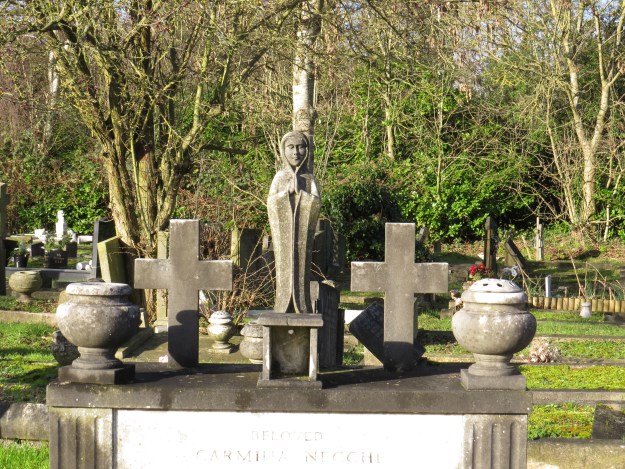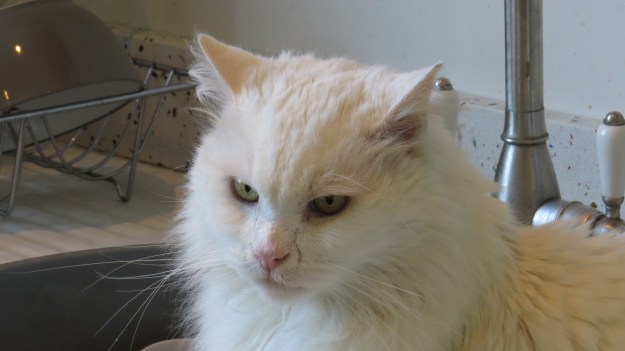
Dear Readers, after the fog, the snow, the icy winds, the rain and the general gloom it was a delight to be in St Pancras and Islington Cemetery today. The crocuses seem to have all burst into life within the past few days: the temperature was in the low thirties Fahrenheit last week, but today it was nearly sixty degrees, and everything seems to be in flower. What a joy it is! I spotted this queen buff-tailed bumblebee in the grass about ten metres from a patch of snowdrops, and I was quite concerned.

I thought she was dead at first, but as I crouched down she reached out with her middle leg in a very clear ‘don’t mess with me gesture’. As I hunkered back and considered what to do she picked herself up and flew in the opposite direction to the snowdrops, only to do a big loop and head back to them. How do they know, I wonder? Are they smelling the flowers, or had she visited before and remembered them? Anyhow, she had a good feed and then headed away at speed, so it was a most welcome false alarm.

There are two kinds of crocuses in the cemetery: Crocus vernus, which is the more typical garden crocus in its shades of purple, yellow, white/maroon and lilac, and Crocus tommasinianus, which is always a delicate lavender colour, and which seems more inclined to naturalise.

Crocus vernus (Spring crocus/Dutch crocus)

Crocus tommasinianus, or Woodland Crocus
Although the Woodland Crocus gets a bit floppy and falls over more easily than the Spring Crocus, I must say that I prefer it to its blousier relative. Some graves are absolutely covered in Woodland crocus, and the bees and hoverflies are already enjoying it. What a joy it is to see some colour after such a long, dark winter. And I am reminded that Woodland Crocus is known as elfenkrokus in German, which is just about perfect.

The native flowers are coming out too. I saw my first Lesser Celandine, but soon the paths will be carpeted with it.

First Lesser Celandine
There’s some red deadnettle, another favourite with the bees….

Some germander speedwell, with its sweet sky-blue and white flowers…

and of course some daisies, with their faces turned towards the sun.

But really it’s the crocuses and the snowdrops that are the stars of the show this week. They lifted my spirits and reminded me that the bulbs that I planted last year won’t be too far behind, though they are always later in my north-facing garden. Here are a few more photos, to cheer you up too…




And finally, it wouldn’t be me if I hadn’t found a grave to puzzle over. I had never noticed this one before, although it is literally the first grave that I pass if I walk my usual route.

There was a big Welsh community in the Kings Cross area of London, and I love how this headstone bears the daffodil, the National Flower of Wales. I used to live very close to Amwell Street, and just half a mile away on Pentonville Road there was a building that used to be the Welsh chapel, with the London Welsh Centre about the same distance away on Grays Inn Road. The story seems to have been a sad one: Lloyd Lloyd was listed as being an ‘invalid for the last seven years’ in 1939, while Margaret was ‘a helper in business’. Their son, David, was a ‘master dairyman and provision merchant’. However, they at least had the money to have not only a servant living with them, but also a male nurse. Margaret passed away in 1946, Lloyd in 1948, and according to the probate records, David received what would have been a very decent inheritance of almost £8,000. A little more digging reveals why – their home at 42 Amwell Street seems to have actually been a dairy, so David had taken over the family business. Something about the name ‘Lloyd’s Dairy’ rang a bell, and so I turned to Google for some help. And here is the site of the dairy. Apparently it opened in 1905 and finally closed about a century later.
What I can’t work out is if there were actually cows on the premises. Many Welshmen, especially from Cardiganshire, set up dairy businesses from about the 1860’s in London, selling milk and cream by the bottle, and also running a milk round. This continued until about 1954, so it’s not ancient history. The dairies tended to pop up along the line of the Euston Road (like this one) so even if cows weren’t kept on the premises, milk could be easily picked up via Paddington Station, which had direct links to the Welsh farms. And (light bulb moment) this is probably why the first trains in the early hours of the morning were known as ‘milk trains’.
It never ceases to amaze me how a simple headstone can reveal so much and yet so little about the people that it commemorates. I now know a lot about Lloyd and Margaret Lloyd, and yet I know nothing about them as people. Still, I think I shall take some daffodils for their grave next time I visit, to say thank you for the insights they’ve provided into a whole area of London life that I knew nothing about.

Lloyds Dairy as it was (Photo One)I found this photo on A London Inheritance, a very interesting site run by one of my classmates from The Gentle Author’s blogging class back in 2014. If you are at all interested in London and how it has changed, I recommend you dash over to A London Inheritance right this minute.
Photo Credit
Photo One from https://collage.cityoflondon.gov.uk/view-item?key=SXsiUCI6eyJ2YWx1ZSI6ImFtd2VsbCBzdHJlZXQgcml2ZXIgc3RyZWV0Iiwib3BlcmF0b3IiOjEsImZ1enp5UHJlZml4TGVuZ3RoIjozLCJmdXp6eU1pblNpbWlsYXJpdHkiOjAuNzUsIm1heFN1Z2dlc3Rpb25zIjozLCJhbHdheXNTdWdnZXN0IjpudWxsfX0&pg=3&WINID=1533845224776#daMHWlkAf9EAAAFlIEy1ag/62626 via https://alondoninheritance.com/london-streets/lloyds-dairy-lloyd-baker-estate/




























































































































